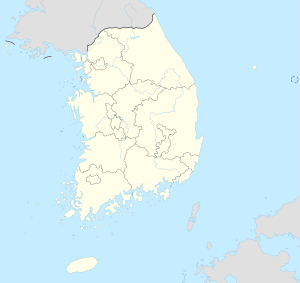Hwaeomsa
| Hwaeomsa | |
|---|---|
| 화엄사 | |

Hwaeomsa Temple in South Korea
|
|
| Basic information | |
| Location | 539 Hwaeomsa-ro Masan-myeon Guryeo-gun South Jeolla Province (Korean: 전라남도 구례군 마산면 화엄사로 539) |
| Geographic coordinates | 35°15′29.84″N 127°29′29.28″E / 35.2582889°N 127.4914667°ECoordinates: 35°15′29.84″N 127°29′29.28″E / 35.2582889°N 127.4914667°E |
| Affiliation | Jogye Order of Korean Buddhism |
| Country | South Korea |
Hwaeomsa (Sino-Korean: hwa-eom-sa 華嚴寺, literally "Flower Garland Temple") is a head temple of the Jogye Order of Korean Buddhism. It is located on the slopes of Jirisan, in Masan-myeon, Gurye County, in the province of South Jeolla Province, South Korea.
An Avatamsaka Sanctuary with 1,000 Years of History
Hwaeomsa Temple (Korean: 화엄사, Chinese: 華嚴寺, Pronounced “Hwa-eom-sa”) was established in 544 by Ven. Yeongi Josa. It was expanded in 643 by Ven. Jajang Yulsa, when the Sakyamuni Relic Pagoda, Seven-Story Pagoda, and a stone lantern were added. During the reign of King Munmu, by royal decree, Ven. Uisang Daesa inscribed the Eighty-Fascicle Avataṃsaka Sutra, on stone tablets and preserved them here. In 875, Ven. Doseon Guksa expanded the temple again.
In 943 during the Goryeo era, honoring the deathbed wish of Ven. Doseon Guksa, the state began to first establish 500 Seon temples, followed by 3,800 “Bibo-sachal,” at sites where bad geomantic energy needed to be transformed. Hwaeomsa Temple was the first temple to be renovated. There were four more renovations thereafter during the reigns of King Gwangjong, King Munjong, King Injong and King Chungsuk.
In 1593, most of Hwaeomsa Temple’s buildings were burned to the ground in the Japanese invasion. However, the temple still preserves pieces of Ven. Uisang Daesa’s stone tablets inscribed with sutras, “Hwaeom Seokgyeong (Treasure No. 1040)” which were left from the tablets shattered in the fire set by the invaders. Later, Ven. Byeogam Gakseong reconstructed some of the buildings, including the Main Buddha Hall (1630-1636).
In 1701, in the 27th year of King Sukjong’s reign, the reconstruction of Hwaeomsa Temple was completed, and the king designated it the great temple of the combined schools of doctrine and meditation. Buildings and gates completed at this time were: Daeungjeon, Gakhwangjeon, Bojeru, Myungbujeon, Wontongjeon, Yeongsanjeong, Eunghyanggak, Jeongmugdang, Geumgangmun and Cheonwangmun.
Of the wealth of cultural properties owned by Hwaeomsa Temple, the first one to catch the eye is Gakhwangjeon Hall (National Treasure No. 67), which literally means “a building where enlightened kings reside.” Though it was built during the reign of Joseon’s King Sukjong, under a state policy that promoted Confucianism and suppressed Buddhism, Gakhwangjeon’s size is only exceeded by Geunjeongjeon, the palace building where the king took care of official business. Gakhwangjeon was built on the former site of Jangnyukjeon, which had been burnt down, and King Sukjong gave the name of “Gakhwangjeon” to the newly-built hall.
...
Wikipedia

